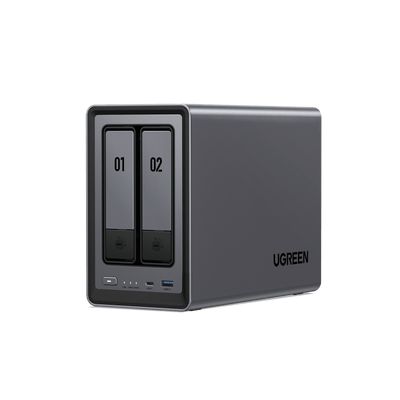How to Speed Up NAS Performance for Multiple Users in 2025
When more than one person accesses a NAS at the same time, the system can slow down or even become unresponsive. This leads to delays, data-saving errors, and frustration, especially in busy environments like small offices, creative teams, or homes with many connected devices. Fast, stable access is critical for uninterrupted productivity.
This article provides simple, helpful advice on how to speed up your NAS so that everyone can get their work done without any problems.

Key Takeaways
- Multi-user slowdowns stem from I/O contention, network bottlenecks, and resource limits (CPU/RAM), causing file delays and save errors.
- Hardware fixes have the biggest impact: add RAM, use SSDs (for storage or cache), and upgrade the CPU if supported.
- Software tuning matters: update firmware, schedule backups off-hours, choose the right RAID (5/6/10) and protocol (SMB for Windows, NFS for Unix/macOS).
- Network upgrades reduce congestion: prefer wired Ethernet, consider 10GbE, and use managed switches to prioritize NAS traffic.
- Ongoing maintenance prevents dips: monitor disk health, replace failing drives early, and keep the NAS cool and dust-free.
Understanding Why Your NAS Slows Down with Multiple Users
When many people try to access files simultaneously, a NAS system can struggle. This usually manifests as slow download speeds, long file-opening times, or errors when trying to save work.
Common problems include:
- I/O Contention: A NAS drive can only handle a certain number of read/write requests at once. When multiple users open large files or run backups at the same time, the system gets overwhelmed, creating a queue that slows things down for everyone.
- Network Bottlenecks: Even a fast NAS can be held back by a slow network. Outdated routers, unmanaged switches, or weak Wi-Fi signals can create traffic jams and cause significant delays.
- Resource Overload: If the NAS doesn’t have enough RAM or a powerful enough processor, it may struggle under a heavy multi-user load. As demand rises, file access becomes less reliable.
To prevent these bottlenecks, consider a unit with upgradable RAM, a stronger CPU, and faster networking—see our NAS storage options for models better suited to heavy multi-user workloads. This makes it easier to match hardware capacity to your team size and file types.

Key factors affecting performance:
- Hardware Limitations: Slow hard drives, insufficient RAM, or an outdated processor can all become bottlenecks, slowing down NAS's read and write speeds. Entry-level models, in particular, may struggle when multiple users access them simultaneously.
- Software Configuration: Incorrect settings, outdated firmware, or using the wrong file-sharing protocol can lead to delays. Some configurations are better suited for single-user access than for a group.
How to Improve Multi-User Performance
For a NAS system to work well with many users, both the hardware and the configuration are very important. A few key changes can reduce delays, speed up access, and prevent crashes during busy periods.
Upgrading Hardware
- Add More RAM: More memory is one of the most effective upgrades, as it allows your NAS to handle more simultaneous processes without slowing down.
- Switch to SSDs: Solid-state drives read and write data much faster than traditional hard drives, significantly reducing wait times.
- Upgrade the CPU: a more powerful processor can handle a greater number of user requests.
For workload-specific advice on SSDs, NAS-grade HDDs, and hybrid setups, see our guide to which drives to use for a NAS—it covers endurance, compatibility, and cost so you know when SSD speed is worth it.
{{UGPRODUCT}}
Optimizing Software
- Keep Software Up to Date: Regular firmware and software updates often include performance improvements and bug fixes that can make your NAS run better.
- Schedule Intensive Tasks: Run demanding processes like system backups or full-volume scans during off-hours, such as at night or on weekends, to avoid impacting users.
- Choose the Right RAID: For a good balance of speed and data protection in a multi-user environment, consider RAID 5, RAID 6, or RAID 10.
- Select the Best Protocol: Use SMB for networks with mostly Windows users or NFS for environments with Unix-based systems like Linux or macOS.
Improving Your Network
- Upgrade to a Faster Network: 10GbE is the gold standard for high-speed data transfer and can dramatically reduce bottlenecks.
- Stick to Wired Connections: Ethernet cables provide faster and more reliable connections than Wi-Fi, which is crucial for consistent performance.
- Manage Network Traffic: To prevent traffic jams during peak hours, consider using a managed switch to prioritize NAS traffic.
Performing Regular Maintenance
Over time, hard drives and SSDs can wear out. Many NAS systems include tools to check the health of your drives. Replacing a failing drive early can prevent data loss and performance issues.
Dust and heat can also cause hardware to slow down. Ensure the NAS has good airflow and is not located in an area that gets too hot.regular upkeep like dusting vents, checking fan curves, and updating firmware also keeps temps (and noise) in check. For a simple, step-by-step checklist, see our NAS maintenance tips guide.
Quick Tips Table
| Category | Action |
|---|---|
| Hardware Upgrades | Add more RAM; use SSDs for caching or storage; upgrade the CPU if possible. |
| Software Settings | Update all software; schedule intensive tasks for off-hours; use RAID 5 or 10; select the appropriate protocol (SMB/NFS). |
| Network Improvements | Upgrade to 10GbE; prioritize wired connections over Wi-Fi; use a managed switch to control traffic. |
| Maintenance | Regularly check disk health; keep the NAS in a cool, clean environment with good airflow. |
FAQs About NAS Storage
Why does my NAS slow down when more people use it?
Each user adds a load on the system’s CPU, memory, drives, and network. If the NAS doesn’t have sufficient resources to handle all the simultaneous requests, performance will drop for everyone.
Will adding SSDs speed things up for multiple users?
Yes. SSDs have much faster read and write speeds than traditional hard drives. This helps reduce wait times significantly when multiple users are accessing or saving files at the same time.
Does Wi-Fi affect NAS performance?
Yes. Wi-Fi is generally slower and less stable than a wired Ethernet connection. For large files and consistent speed, a wired connection is always better.
Do I need 10GbE for better performance?
Not always. For small offices or home use, 1GbE or 2.5GbE may be sufficient. However, if your team works with large files or you have many concurrent users, 10GbE will help reduce delays.
Is RAID setup important for speed?
Yes. Certain RAID levels, like RAID 5 or RAID 10, are designed to balance speed with data protection. Choosing the right configuration can boost performance while keeping your files safe.
I have a basic NAS. Can I still make it faster?
Yes. Try adding more RAM if possible, keeping software up to date, using wired connections, and scheduling backups for off-hours. Even small changes can make a noticeable difference.
Conclusion
Getting faster read and write speeds from your NAS doesn’t always require a major overhaul. Small, targeted improvements to your hardware, software, and network can make a significant difference. Better drives, optimized system settings, and a faster network setup all contribute to a smoother experience for everyone.
If you’re still seeing slow speeds after trying these changes, it might be time to check for faulty hardware or consider upgrading to a more powerful system.



